Introduction: The Antwerp Context
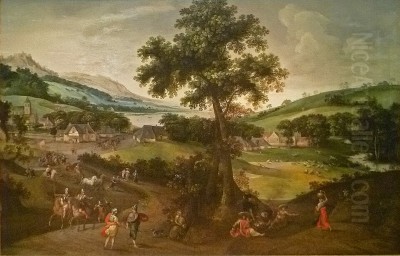
Jacob Grimmer (c. 1525/26 – before May 1590) stands as a significant figure in the rich tapestry of 16th-century Flemish art. Active primarily in Antwerp, the bustling economic and cultural heart of the Low Countries during his lifetime, Grimmer specialized in landscape painting. He emerged during a period of profound transition, both in the artistic representation of nature and in the socio-political climate of the region. His work marks a pivotal shift away from the fantastical 'world landscapes' of earlier generations towards a more naturalistic, intimate, and recognizably local portrayal of the Flemish countryside.
Antwerp in the mid-16th century was a crucible of artistic innovation and commercial exchange. The city's wealth attracted artists from across Europe, fostering a competitive yet collaborative environment. The Guild of Saint Luke, the city's powerful artists' guild, regulated training and production, ensuring high standards. It was within this dynamic setting that Jacob Grimmer honed his craft, developing a distinctive style that captured the serene beauty and everyday rhythms of rural life around his native city, earning him considerable acclaim during his lifetime and leaving a lasting legacy.
Early Life and Artistic Formation
Born in Antwerp around 1525 or 1526, Jacob Grimmer was the son of Nicolaas Grimmer, described as a small merchant (or possibly a dealer in painted cloths), and Elisabeth Cops. Details about his earliest years are scarce, but his path towards an artistic career began formally in 1539. In that year, records show him entering an apprenticeship within the Antwerp Guild of Saint Luke. This marked the standard entry point for aspiring painters, sculptors, and other craftsmen in the city.
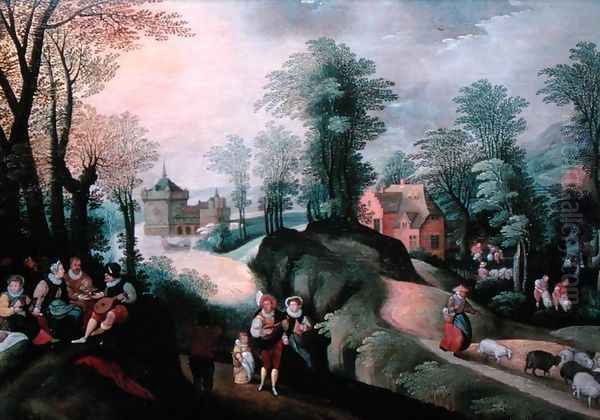
His training involved learning from established masters. Sources mention several potential teachers, reflecting the sometimes ambiguous nature of historical records. He is documented as having studied under Matthijs Cock (also spelled Matthys Cock), a notable landscape painter himself and brother of the influential print publisher Hieronymus Cock. Other sources list Gabriel Bouwens and potentially Christiaan van den Queborn (or Christian van den Sequeulin/Sestian van den Cruycken, names vary in records) as his instructors. Studying under multiple masters was not uncommon and would have exposed Grimmer to various techniques and stylistic approaches prevalent in Antwerp at the time.
After completing his apprenticeship, Jacob Grimmer achieved the status of a free master within the Guild of Saint Luke in 1547. This designation allowed him to establish his own workshop, take on apprentices, and sell his works independently. Shortly thereafter, in 1548, he married Lucia van de Wouwer. The couple would go on to have at least four children, including Abel Grimmer, who would follow in his father's footsteps to become a successful painter in his own right, ensuring the continuation of the Grimmer artistic legacy into the next generation.
The Artistic Milieu of 16th-Century Antwerp
To fully appreciate Jacob Grimmer's contribution, it's essential to understand the artistic environment of 16th-century Antwerp. The city was not just a commercial powerhouse; it was arguably the most important center for art production north of the Alps. The demand for art, fueled by wealthy merchants, nobles, and the Church, was immense. This created a fertile ground for specialization, with artists focusing on specific genres like portraiture, history painting, still life, and, increasingly, landscape.
The landscape genre itself was undergoing significant evolution. Early pioneers like Joachim Patinir and Herri met de Bles, active earlier in the century, had established the 'world landscape' (Weltlandschaft) tradition. These were often panoramic, high-viewpoint compositions featuring dramatic rock formations, vast distances, and fantastical elements, serving as settings for small biblical or mythological scenes. While impressive, they prioritized invention over topographical accuracy.
By the mid-century, tastes began to shift. Artists like Matthijs Cock, Grimmer's teacher, and Cornelis Massys started exploring more naturalistic approaches. However, the towering figure who revolutionized landscape and genre painting was Pieter Bruegel the Elder. Bruegel, active in Antwerp before moving to Brussels, combined panoramic scope with an unprecedented focus on peasant life and keenly observed natural detail, profoundly influencing his contemporaries, including Grimmer. The print publishing house run by Hieronymus Cock also played a crucial role, disseminating landscape designs by Bruegel and others, popularizing the genre further.
Grimmer's Stylistic Departure: Towards Naturalism
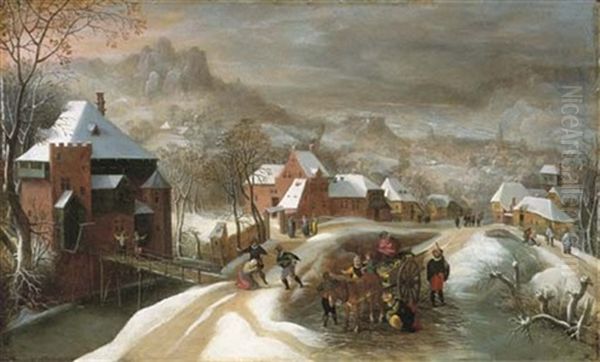
Jacob Grimmer emerged as a key proponent of this move towards greater naturalism in landscape painting. While clearly aware of the work of Patinir and Bruegel, Grimmer forged his own distinct path. He largely abandoned the dramatic, often imaginary, vistas of the early world landscape painters. Instead, he focused on depicting the gentler, flatter countryside surrounding Antwerp, rendering it with a sense of familiarity and intimacy.
His compositions often feature a lower viewpoint than those of Patinir or even early Bruegel, drawing the viewer more directly into the scene. While still employing some conventions like the three-color scheme (brown foreground, green middle ground, blue background) to create atmospheric perspective, Grimmer's application was often softer and more integrated. He developed a preference for simplified, clearly structured compositions, often organized along gentle diagonals or featuring a calm, horizontal emphasis.
A hallmark of Grimmer's style is his use of color and light. His palettes are typically characterized by soft, harmonious tones – greens, blues, ochres, and browns – often unified by a silvery or golden light that imbues his scenes with a tranquil, sometimes idyllic, atmosphere. He avoided the stark contrasts and dramatic intensity found in some contemporary works, favoring instead a more balanced and decorative overall effect. This clarity and calmness made his works highly appealing to collectors seeking pleasant, evocative depictions of rural life.
Themes and Subject Matter: The Flemish Countryside
Jacob Grimmer's primary subject was the Flemish landscape, observed through the changing seasons and populated by the activities of rural inhabitants. He became particularly renowned for his series depicting the Four Seasons and the Twelve Months, themes popularized by Pieter Bruegel the Elder but interpreted by Grimmer with his characteristic gentleness and focus on specific, recognizable locations around Antwerp.
These series allowed Grimmer to explore the cyclical nature of agricultural life and the varied atmospheric conditions throughout the year. Works like Summer, often showing peasants harvesting grain under a warm sun, or Winter (and related paintings like Preparations for Winter), depicting villagers skating on frozen rivers or gathering firewood against a snowy backdrop, became signature pieces. These scenes were not merely topographical records; they conveyed a sense of harmony between humanity and nature, reflecting perhaps an idealized view of country life sought by urban patrons.
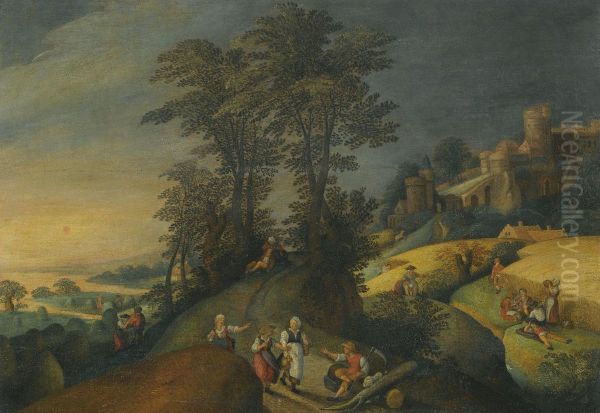
His landscapes frequently include architectural elements – farmhouses, village churches, windmills, castles, and bridges – rendered with considerable attention to their structure, contributing to the sense of place. While figures populate his scenes, they are often relatively small, integrated into the landscape rather than dominating it. They are shown engaged in typical rural tasks: ploughing, sowing, harvesting, tending livestock, traveling along country roads, or enjoying leisure activities like village fairs (kermesses) or skating. The Panoramic Landscape with Shepherds near a Castle exemplifies his ability to blend pastoral elements with grander architectural features within a cohesive, atmospheric setting.
Occasionally, Grimmer tackled religious or mythological themes, but typically placed them within expansive landscape settings. His depictions of the Tower of Babel, for instance, follow a tradition established by artists like Bruegel, but often emphasize the surrounding landscape as much as the biblical structure itself. These works demonstrate his versatility while remaining rooted in his primary strength as a landscape painter.
Collaboration and Workshop Practices
In the bustling Antwerp art market, collaboration between specialized artists was a common and efficient practice. Landscape painters often teamed up with figure painters (staffage specialists) to complete works more quickly and cater to market demands. Jacob Grimmer frequently participated in such collaborations, primarily focusing on the landscape elements himself.
Evidence suggests he regularly worked with Marten van Cleve and Gillis Mostaert, both accomplished figure painters active in Antwerp. These artists would add the human figures and sometimes animals to Grimmer's pre-painted landscapes. This division of labor allowed each artist to focus on their area of expertise, resulting in high-quality finished products. Marten van Cleve, known for his lively peasant scenes reminiscent of Bruegel, and Gillis Mostaert, versatile in both genre figures and religious scenes, were ideal partners whose styles complemented Grimmer's tranquil settings.
This collaborative approach does not diminish Grimmer's authorship of the landscapes themselves, which bear his distinct stylistic signature. It reflects the pragmatic realities of art production in the 16th century, where workshops often functioned as efficient production units. It also highlights the interconnectedness of the Antwerp artistic community, where painters frequently interacted, influenced each other, and worked together on commissions. While direct competition certainly existed, particularly with highly successful artists like Bruegel, cooperative practices were equally important for sustaining careers and meeting market demands.
The Influence of Bruegel and Bol
No discussion of Jacob Grimmer can ignore the influence of Pieter Bruegel the Elder (c. 1525-1569) and Hans Bol (1534-1593). Bruegel, arguably the most innovative landscape and genre painter of the century, cast a long shadow over his contemporaries. Grimmer clearly absorbed lessons from Bruegel, particularly in the choice of themes like the Months and Seasons, the focus on peasant life, and certain compositional structures.
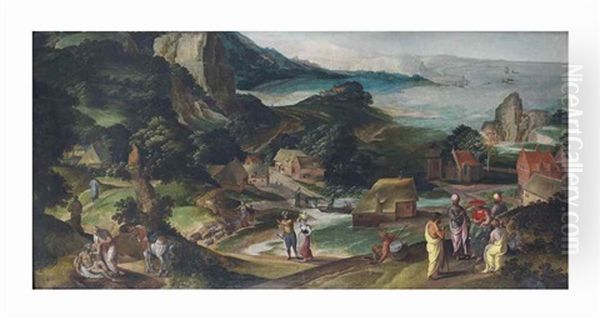
However, Grimmer adapted rather than merely imitated Bruegel's style. Where Bruegel's work often contains complex allegories, social commentary, and a powerful, sometimes unsettling energy, Grimmer's interpretations are generally more straightforward, serene, and decorative. He simplified Bruegel's often densely populated scenes and softened his robust figures, creating landscapes that emphasized peace and order over dynamic struggle or moral complexity. Grimmer offered a gentler, more accessible vision of the countryside compared to Bruegel's profound and often challenging works.
Hans Bol, another prominent Antwerp artist known for his detailed small-scale landscapes, drawings, and miniatures, also seems to have influenced Grimmer, or at least shared a similar artistic trajectory. Bol, like Grimmer, specialized in seasonal depictions and detailed views of the Flemish countryside, often working on a smaller, more intimate scale suitable for cabinet collections. Both artists contributed significantly to the popularization of landscape as an independent genre, catering to the growing demand from middle-class collectors for pleasant, naturalistic scenes. Their shared interest in detailed observation and atmospheric effects places them firmly within the developing tradition of Flemish realism.
Grimmer's Legacy: Abel Grimmer and Beyond
Jacob Grimmer's influence extended directly to his son, Abel Grimmer (c. 1570 – c. 1620). Abel trained in his father's workshop and largely continued his father's artistic preoccupations, specializing in small-scale landscapes, often circular (tondi), depicting the Seasons, Months, biblical parables set in rural landscapes, and church interiors. Abel inherited Jacob's clear compositional structures, bright palettes, and interest in architectural details.
While Abel's style is deeply indebted to his father's, he developed his own nuances, sometimes displaying a more refined technique and a greater interest in perspective effects, particularly in his church interiors. The Grimmer workshop, under both Jacob and later Abel, produced a significant number of works, often variations on successful themes, indicating a well-organized and commercially successful enterprise. The similarity in style between father and son has sometimes led to difficulties in attribution, particularly for unsigned works from the workshop.
Beyond his direct familial legacy, Jacob Grimmer played a crucial role in the broader development of Flemish landscape painting. He stands as a key transitional figure between the imaginative world landscapes of the early 16th century and the more naturalistic, locally focused landscapes that would flourish in the 17th century with artists like Jan Brueghel the Elder (son of Pieter Bruegel the Elder) and Joos de Momper. Grimmer's emphasis on observation, simplified compositions, and atmospheric rendering helped pave the way for the Golden Age of Flemish and Dutch landscape painting. His ability to create appealing, well-structured, and recognizably Flemish scenes solidified the landscape genre's popularity and independence.
Grimmer the Rhetorician: Art and Literature

Interestingly, Jacob Grimmer's talents were not confined solely to painting. Contemporary sources, including the early art historian Karel van Mander in his Schilder-boeck (Book of Painters) of 1604, note that Grimmer was also active as a poet and playwright. He was associated with one of Antwerp's chambers of rhetoric, the Violieren, which was linked to the Guild of Saint Luke.
These chambers were literary and dramatic societies that played a significant role in the cultural life of Flemish cities. They organized competitions, staged plays (often allegorical or moralizing), and fostered literary pursuits among their members, who typically came from the educated middle and upper classes. Grimmer's involvement suggests a man of broader cultural interests beyond his painterly craft.
While none of Grimmer's literary works are known to survive, his participation in the Violieren places him within a circle of culturally engaged citizens and fellow artists. This dual identity as painter and poet, though perhaps secondary to his painting career, adds another dimension to our understanding of him as an individual embedded in the vibrant intellectual life of Renaissance Antwerp. It underscores the often-interconnected nature of artistic and literary pursuits during this period.
Later Reputation and Collections
During his lifetime, Jacob Grimmer enjoyed considerable success and recognition. Karel van Mander praised him as a good landscape painter, particularly highlighting his ability to render skies and his pleasant depictions of villages and farmhouses integrated into the landscape. His works were sought after by collectors in Antwerp and beyond. The sheer number of surviving paintings attributed to him and his workshop attests to his productivity and popularity.
His reputation endured after his death, particularly through the continuation of his style by his son Abel. While perhaps overshadowed in later art historical narratives by the towering genius of Pieter Bruegel the Elder or the dazzling innovations of 17th-century landscape painters, Grimmer has consistently been recognized by specialists for his important contribution to the genre. His role in simplifying landscape composition and emphasizing naturalistic observation was crucial for the genre's evolution.
Today, Jacob Grimmer's paintings are held in major museums and private collections worldwide. Significant holdings can be found in the Royal Museum of Fine Arts Antwerp, the Kunsthistorisches Museum in Vienna, the Prado Museum in Madrid, the National Gallery in London, and many other institutions. His works continue to be appreciated for their charming depiction of 16th-century Flemish rural life, their compositional clarity, and their serene, atmospheric quality, offering a valuable window onto the art and environment of his time. Other artists whose work provides context or comparison include Lucas van Valckenborch and Gillis van Coninxloo, who also explored landscape themes with distinct approaches during the same era.
Conclusion: A Pioneer of Flemish Naturalism
Jacob Grimmer occupies a vital place in the history of Flemish art. As a master landscape painter active during a period of significant artistic change, he skillfully navigated the transition from the imaginative world landscapes of his predecessors towards a more grounded, naturalistic portrayal of his native environment. Working in the dynamic hub of Antwerp, he absorbed influences from masters like Matthijs Cock and Pieter Bruegel the Elder, yet developed a distinctive personal style characterized by simplified compositions, harmonious color palettes, silvery light, and a focus on the tranquil rhythms of rural life around Antwerp.
His popular series depicting the Four Seasons and Twelve Months, often created in collaboration with figure specialists like Marten van Cleve and Gillis Mostaert, captured the essence of the Flemish countryside and catered to a growing market for landscape painting. He was not only a prolific painter but also a man of culture, involved in Antwerp's literary circles. His artistic legacy was directly continued by his son Abel Grimmer and contributed significantly to the foundations upon which the great tradition of 17th-century Flemish and Dutch landscape painting was built. Jacob Grimmer remains celebrated for his serene, well-crafted, and historically important depictions of the world he observed.